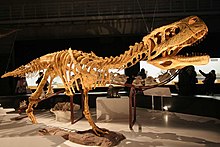Aucasaurus
| Aucasaurus | |
|---|---|

| |
| Mounted skeleton reconstruction | |
| Scientific classification | |
| Domain: | Eukaryota |
| Kingdom: | Animalia |
| Phylum: | Chordata |
| Clade: | Dinosauria |
| Clade: | Saurischia |
| Clade: | Theropoda |
| Family: | †Abelisauridae |
| Tribe: | †Carnotaurini |
| Genus: | †Aucasaurus Coria et al., 2002 |
| Type species | |
| †Aucasaurus garridoi Coria et al., 2002
| |
| Synonyms | |
| |
Aucasaurus is a genus of medium-sized abelisaurid theropod dinosaur from Argentina that lived during the Late Cretaceous (Santonian to Campanian stage) of the Anacleto Formation.[1] It was smaller than the related Carnotaurus, although more derived in some ways, such as its extremely reduced arms and almost total lack of fingers.[2] The type skeleton is complete to the thirteenth caudal vertebra, and so is relatively well understood, and is the most complete abelisaurid yet described. However, the skull is damaged, causing some paleontologists to speculate that it was involved in a fight prior to death.[3]
In 2009, Novas suggested that Aucasaurus garridoi might be a junior synonym of Abelisaurus comahuensis.[4] In 2010, Gregory S. Paul renamed Aucasaurus garridoi into Abelisaurus garridoi.[5] Despite their similarities, other researchers have placed both genera as separate taxa.[6]
Discovery[edit]
Aucasaurus is known from finds in the Río Colorado Subgroup, a Late Cretaceous group comprising the Anacleto Formation in the Neuquén Basin of Argentina that has yielded many dinosaur fossils. Numerous sauropod eggs are also known from this deposit.[7]
Description[edit]


Aucasaurus was a medium-sized abelisaur, measuring 5.5–6.2 m (18–20 ft) long and weighing approximately 700 kg (1,500 lb).[5][8][9] Its skull was not as short or as deep-snouted as that of Carnotaurus. Also, instead of horns, it had a pair of low ridges above each eye.[7]
Forelimbs and hands[edit]
The small arms of Aucasaurus were also like that of its horned relative, but were proportionally longer due to its small size, and the bones lacked the bony processes and some unusual proportions present in Carnotaurus. The hand of Aucasaurus was unusual: four metacarpals were present, but the first and fourth lacked fingers. The second and third had fingers, but they were quite short and had no claws.[7]
Braincase[edit]

A study was done on the braincase of Aucasaurus in 2015 by Ariana Paulina-Carabajal and Cecilia Succar, in which the skull material was scanned using a medical CT machine. Virtual three-dimensional inner ear and cranial endocasts were obtained and visualized using the imagine software at the University of Alberta. A latex cranial endocast was also made. The forebrain, midbrain, and hindbrain resemble the morphology described for the abelisaurids Majungasaurus and Indosaurus. However, Aucasaurus exhibits a floccular process that is relatively larger than that of Majungasaurus. In Aucasaurus the flocculus is enclosed in an 8-shaped floccular recess, similar in shape and size to that observed in Abelisaurus, suggesting that the two Patagonian taxa were capable of a slightly wider range of movements of the head. The labyrinth of the inner ear is similar in shape and size to the semicircular canals of Majungasaurus, although the lateral semicircular canal is shorter in Aucasaurus.[10]
Pathology[edit]

The 5th and 6th holotype tail vertebrae of Aucasaurus provide evidence of failed developmental vertebral segmentation, so two of the vertebrae are fused. Baiano et al. (2024) interpret this as a congenital disorder (birth defect) called block vertebrae. This represents the earliest known occurrence of this pathology in the non-avian theropod fossil record.[11]
Classification[edit]
Aucasaurus was closely related to Carnotaurus and they are united in the Carnotaurini.[7]
Below is a cladogram by Canalle et al. in 2009.[6]
See also[edit]
References[edit]
- ^ The Theropod Database on Aucasaurus
- ^ Coria, R. A.; Chiappe, L. M.; Dingus, L. (2002). "A new close relative of Carnotaurus sastrei Bonaparte 1985 (Theropoda: Abelisauridae) from the Late Cretaceous of Patagonia". Journal of Vertebrate Paleontology. 22 (2): 460. doi:10.1671/0272-4634(2002)022[0460:ANCROC]2.0.CO;2. S2CID 131148538.
- ^ Dingus, Lowell; Chiappe, Luis M.; Coria, Rodolfo A. (2007). "Chapter 8 – What Other Dinosaurs Lived at Auca Mahuevo?". Dinosaur Eggs Discovered!: Unscrambling the Clues. Twenty-First Century Books. p. 83. ISBN 978-0822567912.
- ^ Novas, F.E. (2009). The Age of Dinosaurs in South America. Indiana University Press. p. 281. ISBN 9780253352897.
- ^ a b Paul, G.S. (2010). The Princeton Field Guide to Dinosaurs. Princeton University Press. p. 79. ISBN 9781400836154.
- ^ a b Canale, J. I.; Scanferla, C. A.; Agnolin, F. L.; Novas, F. E. (2008). "New carnivorous dinosaur from the Late Cretaceous of NW Patagonia and the evolution of abelisaurid theropods" (PDF). Naturwissenschaften. 96 (3): 409–414. Bibcode:2009NW.....96..409C. doi:10.1007/s00114-008-0487-4. hdl:11336/52024. PMID 19057888. S2CID 23619863.
- ^ a b c d Benton, Michael J. (2012). Prehistoric Life. Edinburgh, Scotland: Dorling Kindersley. p. 320. ISBN 978-0-7566-9910-9.
- ^ Grillo, O. N.; Delcourt, R. (2016). "Allometry and body length of abelisauroid theropods: Pycnonemosaurus nevesi is the new king". Cretaceous Research. 69: 71–89. doi:10.1016/j.cretres.2016.09.001.
- ^ de Souza, G.A.; Soares, M.B.; Brum, A.S.; Zucolotto, M.; Sayão, J.M.; Weinschütz, L.C.; Kellner, A.W.A. (2020). "Osteohistology and growth dynamics of the Brazilian noasaurid Vespersaurus paranaensis Langer et al., 2019 (Theropoda: Abelisauroidea)". PeerJ. 8. e9771. doi:10.7717/peerj.9771. PMC 7500327. PMID 32983636.
- ^ Paulina-Carabajal, A.; Succar, C. (2015). "The endocranial morphology and inner ear of the abelisaurid theropod Aucasaurus garridoi" (PDF). Acta Palaeontologica Polonica. doi:10.4202/app.2013.0037.
- ^ Baiano, Mattia A.; Cerda, Ignacio A.; Bertozzo, Filippo; Pol, Diego (2024-01-31). "New information on paleopathologies in non-avian theropod dinosaurs: a case study on South American abelisaurids". BMC Ecology and Evolution. 24 (1): 6. doi:10.1186/s12862-023-02187-x. ISSN 2730-7182. PMC 10829224. PMID 38291378.















